 |
World History
Part II
Mont Saint Michel, the Wonder of the West
Castillho de Andrade
As the time passed by, the small sanctuary constructed by St. Aubert on Mont Saint Michel (see Part I took on a great importance. In 966 Richard I, Duke of Normandy, ordered an abbey added to it. He also replaced the 12 canons assigned to the church with 30 Benedictine monks and later increased the number to 60.
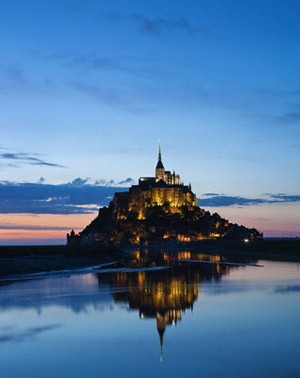
The tide used to cover the passway to the Mont |
His successor, Richard II, the Good (970-1026), whose wedding was celebrated at the Mont, gave rich donations to the monks. Since the Abbey had expanded considerably, a new and imposing church was built. The energy and sanctity of its first Abbots raised the life of the community to a higher level. Under Abbot Robert of Torigny, who governed the island in the mid 12th century, the Abbey became one of the greatest religious and intellectual centers of France.
From the 11th century on, Mont Saint Michel attracted countless pilgrimages. After France rose to her feet to answer the call of the First Crusade, devotion to the Prince of the Celestial Army redoubled in intensity.
Access to the Mont was difficult: The rapidly rising tide threatened the safety of the pilgrims and, when it withdrew, the quicksand could swallow them. "St. Michael of the dangers of the sea" was the name by which the sanctuary was then known. But in those times of faith, not only strong men, but also old men, women and multitudes of children faced these risks to venerate the Archangel.
It is to these pilgrimages, primarily, that the Abbey of Mont Saint Michel owes its prosperity. The faithful made an almost infinite number of small donations, to which were added the great gifts of kings and feudal lords: lands, forests, harvests and even boxes filled with gold were left at the altar. A small village composed of inns and hostelries gradually grew up at the foot of the mountain. The Abbey became one of the wealthiest of France, and this allowed it in the 13th century to construct the buildings that to this day marvel the world.
The gothic 'wonder'
In 1203, during the war against the English King John the Landless, the warriors of Brittany surrounded the Mont. Since they could not take it, they burned it almost completely. Normandy had become French with its inhabitants subjected to the French Crown.
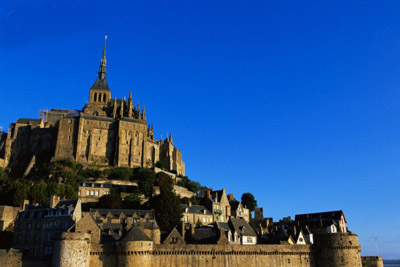
The spire rises over layers of rock buildings |
To repair the disaster of the war and reconcile himself with the monks, French King Philip Augustus (1180-1223) made great donations to the Abbey. With this assistance, Abbot Jourdain commenced work on that prodigious series of buildings called "La Merveille" - The Great Wonder - whose gothic buildings still crown the rock today. It was the 13th century, the apogee of the Middle Ages. The same élan that gave birth to the Crusades engendered from the earth the cathedrals, expressions of the grandeur of the soul and religiosity of the Christian people. The Abbey of Mont Saint Michel is one of the most admirable constructions of that Golden Century of History.
The work of construction on the mount was an extremely difficult task. Due to the narrow confines of space, it was necessary to build the edifices in layers. Thus, the lower buildings had to be very strong to allow the higher ones to rise and assume more elegant forms. It was a herculean work to construct the series of layers of stone buildings that took 30 years to complete.
When it was finished, it astonished the world so much that those who saw it did not hesitate to call it La Merveille, the Marvel, the Wonder. Its gothic rooms express the serenity and elevation of medieval life; the cloister, with its thin, delicate columns, reflects the equilibrium and harmony of the Catholic soul.
In 1254, St. Louis, King of France, visited the recently completed Abbey and enriched it with regal gifts.
Heroic resistance of the monk fortress
The Hundred Years' War (1337-1443) was approaching, when France entered one of the darkest periods of its history. Strong walls were erected around Mont Saint Michel, a bastion on its northern coast set in place of great strategic importance. Thus, that fortified Abbey also became a military headquarters, and the Abbot assumed the double role of superior of the monks and commander of the soldiers.
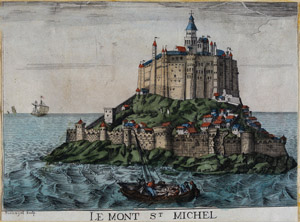
The Abbey became an impregnable fortress |
During the long years of the English invasion, the Mont always remained faithful to the French Crown. Its fortifications, reinforced by Abbot Robert Jolivet, took the shape they have today. After the fall of Rouen in 1419, however, the reigning Abbot changed sides and adhered to the English cause. Then he tried to hand over the fortress to the enemies of France.
In this crisis the fortress knew one of its most heroic hours. Under the command of Captain Louis d'Estouiteville, the monks and the garrison of 119 knights refused to open the fortress to the English and endured 15 years of siege, suffering enormous privations, but resisting all the attacks. The defenders were so audacious that they even ventured forth on sallies that caused grave loss to their enemies. They never surrendered.
St. Michael the Archangel, who appeared to St. Joan of Arc calling her to save the homeland from the English invaders, never permitted his sanctuary to ever be conquered by the enemies of France, whose protector he is.
Decline of spiritual fervor
During that heroic resistance, the church choir caved in. When the war ended, its restoration was undertaken by the new Abbot, Cardinal d'Estouiville, brother of the mentioned Captain, a layman who led the resistance. At the same time, he took steps to open the process for the rehabilitation of St. Joan of Arc. After a long interruption, the new church choir 'wonder of the West.'
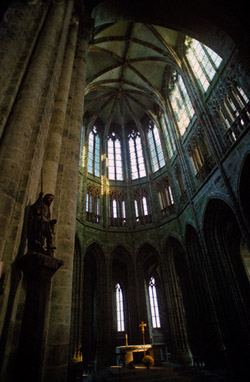
The gothic choir loft towers above the altar |
The year 1442 saw the institution of the Commendatory Abbots, who were arbitrarily named by the royal power and lived at court without great concern for the religious life of their abbeys. This led to the decline of the community of Mont Saint Michel. Nonetheless, during the religious civil war against the Protestants, the Mont remained impregnable, repealing the attacks of the famous Huguenot leader Captain Lorges de Montgomery.
In 1622 the ancient monks were replaced by the reformed Benedictines of St. Maur. Little by little they restored the fervor and the taste for studies in the Abbey, although it did not recover the brilliance and prestige it formerly enjoyed. Unfortunately, those Maurist monks mutilated the church and "la merveille" as they adapted the edifices for their use.
The French Revolution swept through the Abbey with a cyclone of impiety: the monks were dispersed, the Abbey looted, the relics profaned, and the building transformed into a prison for 70 years. The result was new and more extended mutilations.
After that, the Abbey was again occupied by religious men for 12 years. During that time the coronation of St. Michael was celebrated by the French Episcopate, a ceremony attended by 20,000 pilgrims. In 1874 the Abbey was entrusted by the government to the Ministry of Culture. In 1877, the few remaining monks were forced to leave when restoration works began in the government-funded effort to return the buildings to their medieval form and splendor.
Today’s situation
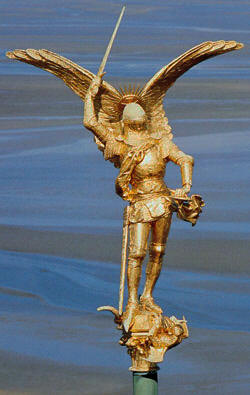
St. Michael stands ready to destroy the enemy and restore the Church |
With the celebration of the sanctuary's 1000th anniversary in 1966, the government allowed the provisory reinstallation of Benedictine monks in the Abbey. In 1969 a permanent group of monks was permitted. However, with the new winds of Vatican II, all deserted their vocations; in 1979 not a single one remained.
In 2001 the Bishop of Coutanges and Avranches asked the charismatic Monastic Fraternity of Jerusalem to send one of its groups to live at the Abbey, which remains the property of the State, administrated by the Center of Historic Monuments.
Notwithstanding these tempests, we know that St. Michael, guardian of the Church, watches over her, just as he continues to watch over the Mont where he wanted the Catholic Church to properly venerate him. The statue that stands atop the steeple shows him wearing medieval armor and branding a sword to defeat the infernal dragon is not just a symbol. It is a promise.
We should trust in his power and nourish the hope that the day will come when, under the command of the Queen of Heaven, St. Michael will annihilate the powers of darkness and implant on earth the kingdom of Our Lord Jesus Christ, Christian Civilization.
In this hour, Mont Saint Michel will return to a true monastic life and receive the due devotion of the faithful to the honor of the Archangel and the greater glory of God.
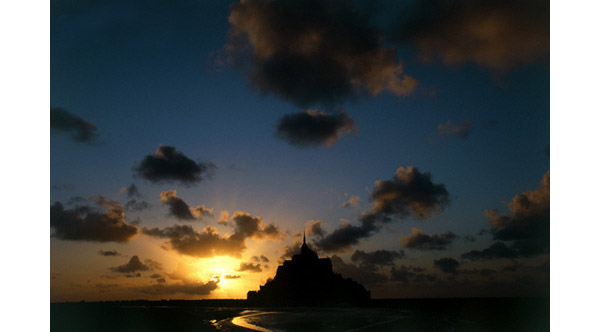
The sun rises over the island offering a magnificent view;
below, an aerial view of the Mont
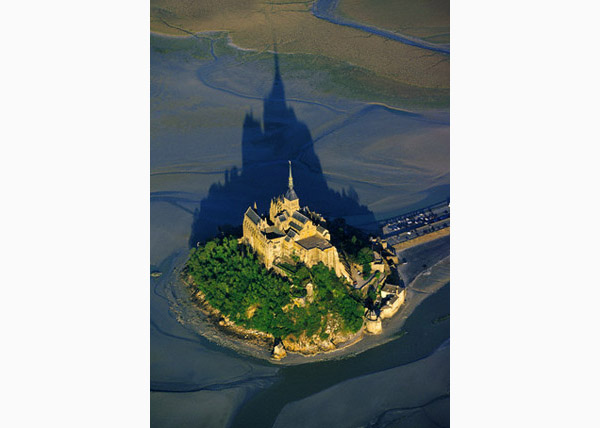
Pictures from Internet |

First published in Catolicismo, April 1953
Posted December 28, 2011

Related Topics of Interest
 The Wonder of the West - Part I The Wonder of the West - Part I
 The Missions of St. Michael the Archangel The Missions of St. Michael the Archangel
 The Middle Ages - A World of Brilliant Colors The Middle Ages - A World of Brilliant Colors
 Refuting Myths of the Middle Ages Refuting Myths of the Middle Ages
 The Exorcism against Satan & the Apostate Angels The Exorcism against Satan & the Apostate Angels
 Prayer to St. Michael the Archangel Prayer to St. Michael the Archangel

Related Works of Interest
|
|
History | Home | Books | CDs | Search | Contact Us | Donate

© 2002- Tradition in Action, Inc. All Rights Reserved
|
 |
|